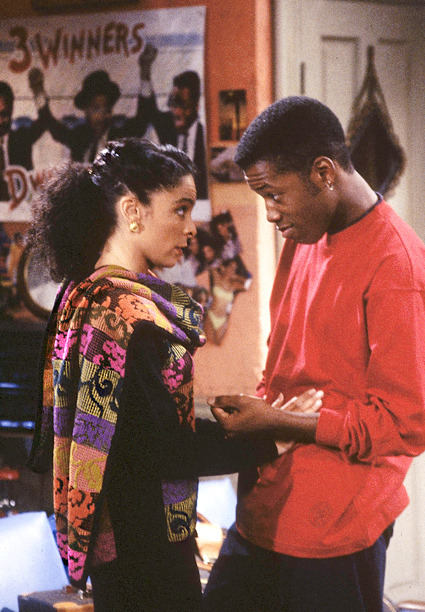1. They have a will- they/won't- they romantic plot line
(above: Whitley and Dwayne from A Different World)
2. Characters fall in and out of love with other characters, until they eventually settle down with the one, who is (usually) a supporting/secondary character on the show
(above Will and Grace season 5, 2002)
3. End - of - season cliffhanger - a plot device that features a main character in a precarious or difficult problem or is confronted with a shocking revelation at the end of the last episode. The cliffhanger leaves viewers wondering what happens right after the episode.
(above: The Jeffersons)
4. Recurring cast of characters and the developing relationships of those characters - helps maintain the continuity, fluidity and familiarity of the plot, & the storylines so viewers can tune in at any stage and still follow the action.
(above: Frasier)
5. They are ongoing and unlike a movie it has no ending
6. Traditional multicamera sitcoms run for 30 mins including adverts, ad breaks cut today's 30 min sitcoms down to just 22 mins
7. Sitcoms draw on real-life experiences, so that the audience can connect with the action and relate to the fictional characters - the characters may not be real, but a lot of the situations that take place depict real -life. If anything, one could see sitcoms as a way of analysing how characters find themselves in a dilemma and how they manage to resolve that problem in the end.
8. Magicom (60s) - sitcom that fuses elements of magic with the real world. An example of a Magicom is 'Bewitched'.
(above: The Fresh Prince of Bel Air)
9. Main characters - characters who carry the show on a regular basis but it tends to be led by one character
(above: Different Strokes' Arnold, Willis, Kimberley, Phillip and Mrs Garrett)
10. Supporting characters - support the main character and act as foils
(above: Lucy Liu on Joey and Neil Patrick Harris on Blossom)
11. Transients - the guest star, walk on characters, supporting guest stars
12. Setting/location: work place, school, at home
13. Problem arises that has to be resolved by the end of the episode
14. A & B story lines: 'A' story line is the main story line of the episode; it runs throughout the show and doesn't resolve until the final scene, 'B' story line is the secondary story line. It acts as nothing more than a slight diversion away from the A story line & sometimes it adds extra tension.
15. The comic trap - term referring to the situation of the sitcom, it's the physical, psychological environment that creates the humourous exchange of banter and ideas
16. Teasers - short scene that appears before the opening credits
17. Binary oppositions - relationships between the characters on the show defined by their opposite qualities; male/female, optimist/pessimist, sarcastic/courteous, young/old
18. Family sitcom/the nuclear family - examples include The Cosby Show, Family Matters, Full House
19. Running gag/joke - funny situation or dialogue that reappears in an episode or series of episodes
George Jefferson slamming the front door in The Jeffersons and Jazz getting thrown out of the house by Uncle Phil on the Fresh Prince of Bel Air are 2 prime examples of the running gag
20. Use of slapstick - slapstick is a style of humour that involves exaggerated physical actions or movements. Very few American sitcoms rely on slapstick but the few that come to mind include Mork and Mindy, The Parkers and Police Squad
21. Spoken word dialogue
22. Limited sets
23. Sitcoms all have an opening theme song/tune, but for the exception of 'My Wife and Kids'
24. Multi - camera sitcoms have either canned or audience laughter
(above: Will Smith on the Fresh Prince of Bel Air)
25. The wisecrack - likes of make fun of others or finds humour in situations
(above: Karen Walker from Will and Grace)
26. The bully/charmer - is not technically a bully per se, but a jerkass or a jerk with a heart of gold
(above: Will Truman from Will and Grace)
27. The square - straight person, straight as in character whose funny lines mostly come from their reactions to situations. That's not to say s/he is unfunny or gets no amusing lines, but rather that they are serious most of the time.
(above: Steve Urkel of Family Mattters)
28. The dork/geek
(above: Phoebe Buffet of Friends and Synclaire James of Living Single)
29. The goofball - typically filled by a ditzy character. The goofball is a character whose defining characteristic is stupidity or silliness
(above: Joey Tribiani of Friends)
30. The charmer - Casanova, the lover and player
(above: C.C Babcock from The Nanny)
31. The stick - uptight and stuffy, pessimistic, is usually humourless
(above: Phillip Drummond of Diff'rent Strokes)
32. The sage - older person who acts as a mentor to the other characters giving advice
(above: Carla of Cheers and Louie from Taxi)
33. The big mouth - often gets on people's nerves, is a know- it- all and becomes very talkative
(above: Olivia Kendall of The Cosby Show)
34. The precocious - youngest member, the child
35. Most of the sitcoms main settings take place in either the home environment or work environment - In some cases, the home environment also doubles up as a working environment and so the character would sleep in the spare room of the house they work in, so that they don't have to travel to go to work.
Source: TV Tropes






No comments:
Post a Comment